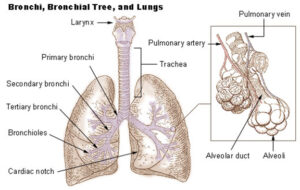With the rise of products like vapes and e-cigarettes, the warning of lung cancer is not unheard of to most teenagers. Lung cancer is the most common cancer across the world, and the third most common cancer in the United States after skin cancer and breast cancer.
In a normal, healthy lung, air enters through the bronchi that divide into bronchioles that ultimately lead to tiny air sacs known as alveoli. The alveoli are the site for gas exchange where oxygen is absorbed, and carbon dioxide is removed. Different types of lung cancer affect different parts of the lungs, but most start in cells that line the bronchi and/or bronchioles and alveoli.
The two main types of lung cancer are non-small cell lung cancer and small cell lung cancer and are largely grouped by the similarities in treatment. Non-small cell lung cancer is more common, making up 80% of all lung cancers. It includes subtypes such as adenocarcinoma, which affects the cells that secrete mucus in the lungs, squamous cell carcinoma, the flat cells that line the airways, and large cell carcinoma, which can affect any cells of the lungs. (Carcinoma is a type of cancer that starts in the cells lining the tissue of an organ). Adenocarcinoma is strongly associated with smoking. Treatment for adenocarcinoma may include surgery to remove the cancer and its surrounding tissue, as well as chemotherapy. Drugs used in chemotherapy are injected to either prevent cancers from getting the hormones they need to grow, or to help the bodies’ immune system fight the cancer.
Non-small cell lung cancer has four main stages, escalating as the cancer starts off in the lungs in stage 1 until eventually spreading to the nearby lymph nodes and to other parts of the body in stages 3 and 4. The other type of lung cancer, small cell lung cancer, grows and spreads faster than non-small cell lung cancer, and therefore responds better to chemotherapy. Doctors usually categorize them only in two stages, limited and extensive. Small cell lung cancer accounts for 10-15% of all lung cancer cases in the United States.
So how does smoking tobacco or vaping contribute or cause lung cancer? Researchers believe that cigarette smoke, which is full of carcinogens, when inhaled can damage the cells that line the inside of the lungs. The chemicals enter the lungs and can damage the DNA in the lung tissue, causing mutations in genes that repair DNA damage or suppress tumor formation. In fact, smoking contributes to over 80% of lung cancer deaths in men and women in the United States.
Many teenagers have begun to vape in the belief that it is less harmful than smoking cigarettes. While there is not as much research analyzing the long-term effects of vaping and e-cigarettes compared to cigarettes, vapes contain nicotine and other chemicals that are potentially toxic to the lung, which increases the risks of lung cancer.
However, lung cancer can also occur in people who have never smoked. In the United States, it is estimated that about 15% of lung cancers, or 30,000 lung cancer cases each year, occur in people who have never smoked. These may be caused by secondhand smoke, being exposed to radon (a radioactive gas), or air pollution. There are cases where people develop lung cancer with no known risk factor for the disease. More research is necessary to understand the factors that cause lung cancer in non-smokers and some of the genetic predispositions behind it.
Currently, research is focused on early detection of lung cancer such as looking for biomarkers and improving existing lung cancer treatment. Although there is not a lot of current information about the long-term effects of other forms of smoking, the fact remains that lung cancer is prevalent problem in our modern society. Given this fact, the importance of understanding the effects and causes of lung cancer are crucial towards maintaining long and healthy lifestyles. With the lack of current research and study, one should remain wary and informed of the use products like vapes and e-cigarettes.
Diagram courtesy of https://training.seer.cancer.gov/anatomy/respiratory/passages/bronchi.html
Resources
